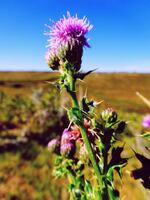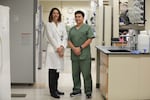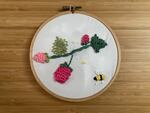
This graphic released by the University of British Columbia shows the differences between the three orca ecotypes that live along the coasts of California and Oregon and the potential unique population.
Courtesy of University of British Columbia
New orca group off Oregon?
The Pacific Northwest has three distinct populations of orcas living off its shores. The residents, the transients and the offshores. They have different ranges, dorsal fin shapes and markings. They eat different kinds of food and even speak different languages.

There is growing evidence that suggests there could be a fourth distinct population of orcas living in the deep ocean off Oregon and California. In this file photo taken on Sep. 9, 2021, an orca swims roughly 110 miles west of Bandon, Oregon.
Robert L. Pitman/Oregon State University
But growing evidence suggests that there could be a fourth distinct population, or ecotype, living in the deep ocean off Oregon and California. Now researchers from the University of British Columbia have collected 25 years’ worth of sightings to understand the range and other distinctive characteristics of these “oceanic” whales.
The 49 new orcas — observed by researchers, fishermen and birders over the years — don’t match individuals in any other population. They have been witnessed hunting a full-sized sperm whale, in addition to other large ocean mammals.
Wounds from cookiecutter sharks seem to be a calling card for the new oceanic population. These small sharks live way offshore in the open ocean and bite round cookie-shaped chunks out of larger fish, sharks and marine mammals. Most of the new orcas have evidence of these bites, leaving the researchers to conclude the whales spend most of their time in deep water.
The paper was published in the journal Aquatic Mammals.

Canada thistle, a noxious weed.
Flickr Creative Commons: Adriana W. Van Leeuwen
Rounding up Roundup
Since the mid-1970s, the herbicide glyphosate (aka Roundup) has been one of the most widely-used weed killers in the world. The Environmental Protection Agency has maintained that glyphosate doesn’t pose a significant risk to human health or the environment. Yet recent challenges to those findings have been successful in court. Roundup producer Monsanto (now Bayer) has started offering billions of dollars in settlements to people who used the herbicide and subsequently developed certain cancers.
All this to say, the future of glyphosate is uncertain, and we might be cleaning it up from the environment, including our drinking water, for decades to come.
Now researchers at Oregon State University have discovered a way to break down and remove glyphosate from groundwater. They’ve identified a specific material that can break down glyphosate into non-hazardous substances through a reaction triggered by light.
The material, consisting of metals and organic compounds bound together, has the ability to remove glyphosate from water in just five minutes.
The results were published in the Nature Communications here.

This photo from OHSU shows Paula Amato, M.D., professor of obstetrics and gynecology in the OHSU School of Medicine, and Shoukhrat Mitalipov, Ph.D., director of the OHSU Center for Embryonic Cell and Gene Therapy on Aug. 4, 2022.
Courtesy of OHSU/Christine Torres Hicks
Increasing baby-making options for some same-sex couples (and others!)
Genetic technology has come a long way in a short period of time. But an area where researchers haven’t fully cracked the code is creating viable human embryos that don’t require the strict sex-based combination of an egg and sperm.
Now researchers at Oregon Health & Science University have developed a way to combine genetic information to produce a viable egg — regardless of the parent’s reproductive sex or medical ability to have children. The process still requires sperm to create a viable embryo, but the egg can be created using skin cells from anyone.
Scientists developed the technique using cells from mice. They stripped the genetic information from a viable egg cell (kind of like taking out the software, but leaving the hardware behind) and injected that egg with chromosomes extracted from a skin cell. The researchers then coaxed the new skin cell-egg hybrid to drop half its chromosomes, making it ready to be fertilized by sperm through in vitro fertilization.
The technique is still far from being ready for use with humans, but it offers a new avenue for male same-sex couples and infertile women to conceive children related to both parents.
The paper in Science Advances can be read here.

University of Washington researchers taught a group of high schoolers to code by combining cultural research into various embroidery traditions with “computational embroidery.” The method teaches kids to encode embroidery patterns on a computer through a coding language called Turtlestitch. In this photo released by the University of Washington, a student stitched plants with code, then hand-embroidered a bee.
Courtesy of Kivuva et al./SIGCSE
Stitching for STEM
Despite concerted efforts to throw the doors open for women and underrepresented BIPOC communities to pursue science, technology, engineering and mathematics (STEM) careers, there is still a wide gap in representation in the workforce.
Researchers at the University of Washington are looking for ways to offer education opportunities specifically tailored to inspire these groups to thrive in STEM fields. They’ve developed a course that uses embroidery to teach basic concepts behind computer coding. The researchers say embroidery has natural links to coding because of the pixel-by-pixel and repetitive nature of the stitching. Through the embroidery, they were also able to offer a cultural connection for students not often present in STEM courses.
The high school students started by learning how to hand-embroider and spent time studying different cultural traditions of embroidery (Mexican, Arab and Japanese) from around the world.
They were then introduced to an open-source web app called TurtleStitch, which is used to “code” patterns for embroidery machines. The class spent several weeks working on designs, while learning coding concepts like loops and functions. The lead researcher plans to adapt the program further for different ages and experiences.
This research was published in the Proceedings of the 55th ACM Technical Symposium on Computer Science Education and can be accessed here.
Carbon-negative decking
People in the United States love decks. We use more than 3 billion linear feet of decking boards each year. In recent years, there’s been a slow shift from wood decking to composite boards, which can be made of recycled plastic and wood fillers. The new composites are more expensive but last longer and require less maintenance.
Now researchers at Pacific Northwest National Lab are adding “carbon negative” to the list of benefits of composite boards.
They’ve developed a new formulation of composite that uses lignin or lignite (both organic industrial waste products) instead of more typical fillers like wood flour. To get the lignin/lignite to bond with the plastic, the scientists created a reaction that attaches carbon dioxide to the surface. In the end, the filler material ends up being up to 5% CO2 by weight.
If manufactured using green methods, the researchers say the material will be carbon negative over its lifetime — a rare thing when it comes to building materials. In addition, the researchers say the material would actually be cheaper to manufacture than traditional composites, and its strength meets international building code standards.
The research was presented at the spring meeting of the American Chemical Society.
Update: “The solution to climate change is rural America.”
Back in 2022, “All Science. No Fiction” featured research about a new paradigm in green energy production. Scientists at Oregon State University were working on ways to fully integrate agriculture and solar power production on the same plot of land in a way that’s mutually beneficial to both.
One of the scientists featured was trying to figure out what mix of pasture plants would be best for grazing lambs around solar power arrays, given the need for the plants to perform well when shaded by the panels. Now she’s published the results in the journal Grass and Forage Science, available here.
Implementing agrivoltaic systems would be a significant shift in the way we approach green energy production and agriculture as a society. Nitty-gritty research like this is vital to provide the information farmers need to make a paradigm shift.
In this monthly rundown from OPB, “All Science. No Fiction.” creator Jes Burns features the most interesting, wondrous and hopeful science coming out of the Pacific Northwest.
And remember: Science builds on the science that came before. No one study tells the whole story.




